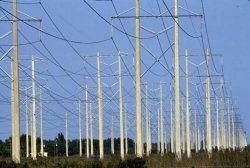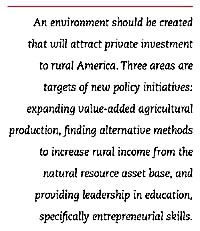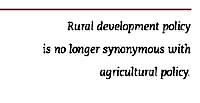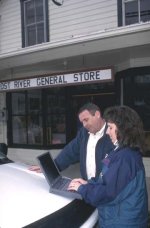
United States Department of Agriculture
USDA Rural Development
| Content | |
| Preface | |
| Chapter 1 | |
| Chapter 2 | |
| Chapter 3 | |
| Chapter 4 | |
| Chapter 5 | |
| Chapter 6 | |
| Chapter 7 | |
| Chapter 8 | |
| Chapter 9 | |
| Chapter 10 | |
| Chapter 11 | |
| Chapter 12 | |

Helping the people of rural America develop sustainable communities and improve their quality of life is the goal of USDA’s Rural Development mission area, which works aggressively to increase economic opportunities and empower rural communities to grow.
USDA Rural Development is working to eliminate substandard housing from rural America by helping families and individuals buy, build, repair, or rent decent housing.

It also creates jobs by providing funding and technical assistance to support the growth and creation of rural businesses and cooperatives. In a typical year, Rural Development programs create or preserve more than 150,000 rural jobs, enable 60,000 to 70,000 rural people to buy homes, and help more than 450,000 low-income rural people rent apartments or other housing.
Other Rural Development programs help rural communities build or improve community facilities, such as schools, health clinics, and fire stations. Rural Development also has programs that help rural communities build or extend utilities, including water, electricity, and telecommunications services. Rural Development is also charged with leadership in national, State, and local strategic planning.
Program assistance is provided in many ways, including direct or guaranteed loans, grants, technical assistance, research, and educational materials. To accomplish its mission, USDA Rural Development often works in partnership with State, local, and tribal governments, as well as rural businesses, cooperatives, and nonprofit agencies.
USDA Rural Development programs are delivered through its three agencies–Rural Utilities Service (RUS), Rural Housing Service (RHS), and Rural Business-Cooperative Service (RBS)–and branch, the Office of Community Development (OCD). Rural Development programs are provided across the Nation through 47 State offices and 800 field offices. The following overviews describe the three Rural Development agencies and branch–the Office of Community Development–and their main programs.
Rural Business-Cooperative Service
Creation of viable new and improved competitive businesses and sustainable cooperatives in rural America is the top priority of the Rural Business-Cooperative Service (RBS). This agency works through partnerships with public and private community-based organizations to provide financial assistance, business planning, and technical assistance to rural businesses. It also conducts research into rural economic issues, including rural cooperatives, and provides educational material to the public.
Business and Industry (B&I) Guaranteed Loans help to finance rural business and industry projects that create employment opportunities and improve the economic and environmental climate in rural communities, including pollution abatement and control. Guaranteed loans are made for projects that foster sustained community benefits and open private credit markets. B&I loan guarantees can be extended to loans made by commercial or other authorized lenders in rural areas (this includes all areas other than cities of more than 50,000 people and their immediately adjacent urban or urbanizing areas).
Under the B&I Guaranteed Loan Program, the Cooperative Stock Purchase Authority provides financial assistance for the purchase of cooperative stock for family-sized farms where the commodities produced are to be processed by the cooperative.
Direct Business and Industry (B&I) Loans are made to public entities and private parties who cannot obtain credit from other sources. Loans to private parties can be made for improving, developing, or financing business and industry, creating jobs, and improving the economic and environmental climate in rural communities (including pollution abatement). This type of assistance is available in rural areas (this includes all areas other than cities of more than 50,000 people and their immediately adjacent urban or urbanizing areas).

Intermediary Relending Program Loans finance business facilities and community development projects in rural areas, including cities of less than 25,000.
Loans to intermediaries are reloaned to support the establishment of new business facilities and community development projects in rural areas. Rural Economic Development Loans and Grants finance economic development and job creation projects in rural areas based on sound economic plans. This financing is available to any Rural Utilities Service electric or telecommunications borrower to assist in developing rural areas from an economic standpoint, to create new job opportunities, and to help retain existing employment. Loans at zero interest are made primarily to finance business startup ventures and business expansion projects.
Grants are made to these telephone and electric utilities to establish revolving loan programs operated at the local level by the utility.

Rural Business Enterprise Grants help public bodies and nonprofit corporations finance and facilitate the development of small and emerging private business enterprises located in rural areas (this includes all areas other than cities of more than 50,000 people and their immediately adjacent urban or urbanizing areas). Grants may be used to acquire and develop land, buildings, plants, equipment, access streets and roads, parking areas, and utility and service extensions. In addition, funds may be used for refinancing, fees for professional services, technical assistance, financial assistance through loans to third parties–including startup costs and working capital, production of television programs targeted to rural residents, and rural distance-learning networks.
Rural Business Opportunity Grants can be made to provide economic planning for rural communities, technical assistance for rural businesses, or training for rural entrepreneurs or economic development officials. Funding must result in economic development of a rural area. This program is available to public bodies, non-profit corporations, Indian tribes, or cooperatives with members who are primarily rural residents.
Rural Cooperative Development Grants finance the establishment and operation of centers for cooperative development. The program enhances the economy of rural areas by developing new cooperatives and fostering improved operations for existing co-ops.
Value-Added Agricultural Product Market Development Grants are available to help farmers and their farmer-owned cooperatives or other businesses to expand the customer base for their products or commodities. An expanded customer base gives producers access to a greater share of the revenues derived from adding value to their crops.
The Agricultural Innovation Center Program provides grants to fund a series of centers to provide information and technical assistance to producers in getting into value-added activities.
The Agricultural Marketing Resource Center grant program establishes a national electronically based center to collect and interpret information about value-added agriculture. It aims to empower the Nation’s agricultural producers and processors by providing publicly accessible information on the Internet.
The Appropriate Technology Transfer for Rural Areas program provides information to farmers and other rural users on a variety of sustainable agricultural practices, including crop and livestock operations. It helps agriculture by giving reliable, practical information on production techniques and practices that reduce costs and are friendly to the environment.
The National Sheep Industry Improvement Center promotes strategic development activities to strengthen and enhance production and marketing of sheep, goats, and their products in the United States. The Center, which has a board of directors to oversee its activities, makes loans and grants.
Cooperative Services helps improve the performance of the Nation’s cooperatives and promotes understanding and use of the cooperative form of business. By working together for their mutual benefit in cooperatives, rural residents are often able to reduce costs for production supplies and consumer goods, obtain services that might otherwise be unavailable, and achieve greater returns for their products.
Cooperative Services accomplishes its mission by (1) responding to requests for technical assistance from rural residents who want to organize a cooperative or improve operations of an existing cooperative; (2) providing information and educational materials relating to cooperatives; (3) conducting research on cooperative financial, structural, managerial, policy, member governance, legal, and social issues; and (4) collecting and disseminating statistics to support research and technical assistance work (sidebar 6-1).
Rural Housing Service
Decent, safe, sanitary, affordable housing and essential community facilities are indispensable to vibrant rural communities. USDA’s Rural Housing Service (RHS) has the responsibility to make these essential elements available to rural Americans. RHS programs help finance new or improved housing for more than 60,000 moderate-, low-, or very low-income families each year. These programs also help rural communities finance construction, enlargement, or improvement of fire stations, libraries, hospitals, medical clinics, day care centers, industrial parks, and other essential community facilities.
Single Family Housing Loans provide assistance to very low-, low-, and moderate-income households in rural communities, helping them to purchase, construct, or repair a home. Very low- and low-income borrowers are offered 33- to 38-year direct loans (depending on income) at fixed interest rates with payment assistance to bring the effective interest rate to as low as 1 percent, depending on the family’s adjusted income. Low- and moderate-income rural residents can be assisted with loan guarantees, which require no downpayment or mortgage insurance, that are offered through private lenders at terms up to 30 years. The loans, both direct and guaranteed, can cover up to 100 percent of market value or acquisition cost, whichever is less. This eliminates the need for a downpayment and provides homeownership opportunities to many more rural Americans.
The innovative Mutual Self-Help Housing Program makes homes more affordable by enabling low- and very low-income families to perform 65 percent of the labor to construct their homes. The family’s investment or "sweat equity" reduces the total amount of money to be borrowed. Grants are awarded to nonprofit and local government organizations that provide technical assistance. They supervise groups of families in the construction of their homes. The families work on homes together, moving in only when all homes are completed. Usually, the homes are financed through an RHS Single Family Housing direct loan. In 2001, RHS made 70 technical assistance grants totaling $17.63 million, to nonprofit organizations in 26 States that helped about 1,417 families build their own homes. A total of $165.3 million was loaned to these families to help them pay for their new homes.
Home Improvement and Repair Loans and Grants enable very low-income rural homeowners to remove health and safety hazards from their homes and to make homes accessible for people with disabilities. Loans have a maximum interest rate of 1 percent and are available to very low-income homeowners regardless of their age.
Grants are available for people age 62 and older who cannot afford to repay a loan. A combination of funds from a loan and grant can be used by eligible elderly residents.
Rural Rental Housing Loans finance construction of rental and cooperative housing for low-income individuals and families with an average annual income of $8,105, including elderly or disabled persons. Loans have a maximum term of 30 years, can equal up to 100 percent of the appraised value or development cost, whichever is less, and can be used to construct new housing or to purchase or rehabilitate existing structures. In addition to the direct lending program, USDA offers loan guarantees to multi-family housing developers to extend the reach of Federal resources to moderate- and low-income working families and elderly individuals.

Housing Preservation Grants are made to nonprofit groups and government agencies to finance rehabilitation of rental units for low-income residents.
Rental Assistance payments subsidize rent costs to ensure that low-income tenants will pay no more than 30 percent of their income for rent.
Community Facilities Loans, Loan Guarantees, and Grants finance the construction, enlargement, extension, or other improvements for community facilities providing essential services in rural areas and towns with a population of 20,000 or less. Funds are available to public entities such as municipalities, counties, special-purpose districts, Indian tribes, and nonprofit corporations. Projects commonly financed include child care centers, schools, libraries, and medical facilities. In addition, funding may be used for the purchase of firefighting equipment.
Housing for Farm Workers
Farm workers are often among
the most poorly housed and lowest paid workers in the United States. RHS
provides hous ing for migrant and farm laborers through several programs. The
Farm Labor Housing program, the only
national farm labor housing program, provides loans to public or nonprofit
agencies or to farmers to enable them to build farm labor housing. In States,
such as California, many farm laborers are able to build their own homes
through our Mutual Self-Help Housing Program.
Outreach to American Indians and Alaskan Natives
The
Rural Housing Service is reaching out to better inform Native Americans about
its programs and is working to overcome institutional barriers to lending on
tribal land. In FY 2001, Single Family Housing direct loans worth $13.6 million
were made to buy or to repair homes for 204 Native Americans, including $2.183
million to build approximately 39 single family houses on tribal lands. An
additional $17.4 million guaranteed another 231 housing loans made to Native
Americans by private sector lenders. Loans and grants made through the Housing
Repair program totaled over $1.3 million and repaired 216 dwellings.

The Community Facilities Program provided more than $32 million in direct and guaranteed loans and grants to fund 77 essential community facilities benefiting Native American tribes in 13 States. These projects included infrastructure for a tribal housing project, tribal school and college classroom buildings, physicians’ clinics, child care centers, museums, fire trucks, a well for water, a food preparation center, and several community centers and general office buildings.
Expanding the Reach of Federal Resources Through
Partnerships
Partnerships with public bodies, such as towns, counties,
and federally recognized Indian tribes, and the private and nonprofit sectors,
form the foundation of several RHS programs. USDA is actively reaching out to
organizations whose goals and missions complement those of the Department. The
following are partnerships found in RHS programs:
-
Some of USDA’s most important partnerships are created through its guaranteed loan programs, which are a collaboration with local lenders by which the lender funds the loan and RHS issues a guarantee for up to 90 percent of the amount of the loan.
-
The Rural Home Loan Partnership (RHLP), begun in 1996, makes private credit more accessible for eligible low-income borrowers. Partners include RHS, Rural Local Initiatives Support Corporation, the Federal Home Loan Bank System, the Neighborhood Reinvestment, Rural Alliance, the Office of Thrift Supervision, the Federal Deposit Insurance Corporation, and the Office of the Comptroller of the Currency. The partnership delivers a new single-family mortgage product that enables families earning 80 percent of area median income or below to achieve homeownership. RHS provides a subsidized mortgage to cover part of the cost of a house, while a local bank finances the remainder. Since RHLP began in 1996, it has provided more than $341.8 million to help 4,329 families in 36 States attain the American dream of homeownership.
Community Development Financial
Institution Partnership
The Community Development Financial
Institution Partnership was created in 1998 to provide homeownership
opportunities to low-income applicants by combining the resources of RHS and
community development financial institutions.
CDFIs are specialized private institutions that serve populations whom traditional financial institutions are not serving. They provide a wide range of financial products and services to underserved communities, including mortgage financing for first-time home buyers and basic financial services needed by low-income households.
Rural Utilities Service
USDA Rural Utilities Service (RUS) programs, including Rural Telephone Bank (RTB) programs administered by RUS, touch the lives of tens of millions of rural people daily. Through project financing and technical assistance, RUS builds infrastructure to provide rural businesses and households with modern telecommunications, electricity, and water.

RUS is a partner with rural business and economic development efforts, providing infrastructure that is the foundation for competitiveness. It is a technical and financial resource in a time of change for rural utilities.
Rural Telecommunications Loans and Loan Guarantees build modern rural communications systems by making financing available for modern high-speed telecommunications facilities. Loans made to rural telephone cooperatives and companies help bring reliable and affordable telecommunications services to more than 15 million rural Americans.
Rural Electric Loans and Loan Guarantees
The RUS
Electric Program provides financing and technical assistance to upgrade,
expand, and maintain the electric utility infrastructure in rural America.
Under the authority of the Rural Electrification Act of 1936, RUS makes direct
loans and loan guarantees to electric utilities to serve customers in rural
areas. Repayment of RUS loans is secured through liens on the assets of
borrowers, long-term power arrangements, and RUS oversight of borrower
activities. RUS can also make loans for renewable energy and demand-side
management activities to boost rural economic development opportunities and
contribute to a cleaner environment. With new authority added in the 106th
Congress, RUS can make grants and loans for rural communities with extremely
high energy costs.
Through RUS, the Federal Government is the primary lender and majority note-holder for 697 rural electric systems in 46 States, Puerto Rico, the Marshall Islands, and the Virgin Islands. These active RUS borrowers directly serve over 25 million people. In 2000 RUS borrowers accounted for over 10.8 million retail meters (90 percent of them residential meters), 1,689,000 miles of distribution lines, 96,000 miles of transmission lines, 162,699,000 megawatt-hours (MWh) generated, and 240,147,000 MWh in retail sales.
Of the 697 RUS-financed rural systems, nearly 96 percent are nonprofit cooperatives, owned and operated by the consumers they serve. The remaining 4 percent include municipal systems, public power districts, Native American tribal utilities, and other entities. RUS-financed electric systems provide service to 523 of the 540 identified persistent poverty counties and 655 of the 700 counties identified as having net outmigration.
Distance Learning and Telemedicine Loans and Grants bring distance learning and telemedicine to rural America. Education and adequate medical care are crucial to the survival of rural communities, but are becoming increasingly difficult to provide. This program employs innovative ways to use telecommunications infrastructure to extend the reach of educational and medical expertise into communities without those resources. The loan program has been expanded to broaden the use of rural telecommunications infrastructure.
Water and Waste Disposal Loans and Grants develop water and waste disposal systems (including solid waste disposal and storm drainage) in rural areas and towns with populations of less than 10,000. The funds are available to public entities such as municipalities, counties, special-purpose districts, Indian tribes, and nonprofit corporations. RUS also guarantees water and waste disposal loans made by banks and other eligible lenders. This program deals with over 7,000 communities nationwide.
Office of Community Development
The Office of Community Development’s goal is to create empowered communities–no longer beset by hopelessness, pervasive poverty, unemployment, and general distress. These communities should be able to implement self-generated strategic plans that solve some of their most difficult economic and social challenges. OCD promotes Federal, State, and local agencies, private sector, and not-for-profit organizations working cooperatively and in partnership with communities.
USDA Rural Development’s Office of Community Development (OCD) administers the Rural Community Development program. This effort promotes self-sustaining, long-term economic and community development in areas of pervasive poverty, unemployment, and general distress. The program works by helping distressed communities develop and implement innovative, comprehensive strategic plans, which are supported by partnerships among private, public, and nonprofit entities. This assistance is available through USDA Rural Development field offices to rural communities throughout the United States. This help includes technical assistance and support in obtaining additional financial resources and assistance in forging local and regional partnerships.
USDA’s Office of Community Development administers three rural community empowerment efforts: Empowerment Zones/Enterprise Communities (EZ/EC), Champion Communities (CC), and the Rural Economic Area Partnership (REAP) Zones. OCD also administers the Rural Community Advancement Program (RCAP) and other supported communities, as well as the National Centers of Excellence.
Empowerment Zones/Enterprise Communities
The
Empowerment Zones/Enterprise Communities (EZ/EC) Program provides economically
depressed rural areas and communities with real opportunities for growth and
revitalization. Its mission is to help create long-term economic and community
development and assist communities in empowering themselves to improve local
conditions and become self-sustaining. EZ/EC efforts begin at a grassroots
level, where communities, in cooperation with State and local governments, work
together to write strategic plans to address the economic and social problems
they face. The strategic plan also identifies partnerships and ways to
combineprivate and public resources to implement their plans (sidebar 6-2).
Key features of the EZ/EC program include:
-
Rural EZs receive substantial flexible grant dollars to help implement their strategic plans. Rural ECs receive somewhat less for the same purpose.
-
Rural EZs are eligible for tax credits, such as the Work Opportunity Tax Credit and Section 179 tax deductions, as well as tax-free facility bonds.
-
Both rural EZs and ECs receive primary consideration for many other Federal and State programs.
In 1994, the Round I EZ/EC designations named three rural Empowerment Zones and 30 Enterprise Communities. In 1998, five Round II rural Empowerment Zones and 20 Enterprise Communities were designated. A third round of two additional rural EZs was named in December 2001. In 1999, USDA formalized the Champion Communities (CC) program by inviting all communities that submitted strategic plans for Round I and II EZ/EC designations to continue implementing their plans through a partnership agreement with USDA.
Rural Economic Area Partnership (REAP) Zones
While
poverty-related issues are the main challenge for some rural communities, many
others face economic and community development issues of a very different
character. Often, these challenges are due to geographic isolation, low
population density, over-dependence on agriculture, population loss,
out-migration, and economic distress. To address these issues, USDA advocated a
pilot concept for ruralrevitalization and community development called Rural
Economic Area Partnership Zones. Two zones in North Dakota were designated in
1995 to be the first participants in the REAP initiative. In 1999, two areas in
upstate New York were added, and in 2000 an area in Vermont was designated as
the fifth zone. The North Dakota zones and the Vermont zone cover multi-county
areas, while the two in New York are basically single counties. Each REAP Zone
developed a strategic plan for economic revitalization. Through grassroots
efforts in strategic planning and community action, millions of dollars in
State, Federal, private, and nonprofit assistance are being brought to these
areas.
Rural Community Advancement Program (RCAP)
The 1996
Farm Bill established the Rural Community Advancement Program (RCAP). RCAP
features strategic planning assistance, grants, loans, loan guarantees, and
other assistance to meet the development needs of rural communities. Special
emphasis is placed on the smallest communities with the lowest per capita
income.
National Centers of Excellence: College and University
Partnership Project
The National Centers of Excellence(NCE) program has
matured into a unique effort to utilize local universities and colleges as
catalysts for rural economic and community development. The NCE is a
partnership between USDA and rural colleges and universities in the United
States. The goal of the program is to improve the economic self-sufficiency of
historically overlooked, poor rural communities. It specifically focuses on
building the economic and community development educational and outreach
capacities of the rural colleges and universities and linking them with
impoverished rural communities that they have historically served.
The National Centers of Excellence participating in 2002 include: University of Texas-Pan American, Texas; Somerset Community College, Kentucky; Heritage College, Washington; Cankdeska Cikana Community College, North Dakota; Crownpoint Institute of Technology, New Mexico; Fort Peck Community College, Montana; San Diego State University-Imperial Valley, California; and California State University-Fresno, California.